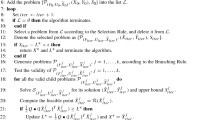Abstract
In the k-terminal cut problem, we are given a graph with edge weights and k distinct vertices called “terminals.” The goal is to remove a minimum weight collection of edges from the graph such that there is no path between any pair of terminals. The k-terminal cut problem is NP-hard. The k-terminal cut problem has been extensively studied and a number of algorithms have been devised for it. Most are approximation algorithms. There are also fixed-parameter tractable algorithms, but none have been shown empirically practical. It is also possible to apply implicit enumeration using any integer programming formulation of the problem and solve it with a branch-and-bound algorithm. Here, we present a branch-and-bound algorithm for the k-terminal cut problem which does not rely on an integer programming formulation. Our algorithm employs “minimum isolating cuts” and, for this reason, we call our branch-and-bound algorithm Isolation Branching. In an empirical experiment, we compare the performance of Isolation Branching to that of a branch-and-bound applied to the strongest known integer programming formulation of k-terminal cut. The integer programming branch-and-bound procedure is implemented with Gurobi, a commercial mixed-integer programming solver. We compare the performance of the two approaches for real-world instances and simulated data. The results on real data indicate that Isolation Branching, coded in Python, runs an order of magnitude faster than Gurobi for problems of sizes of up to tens of thousands of vertices and hundreds of thousands of edges. Our results on simulated data also indicate that Isolation Branching scales more effectively. Though we primarily focus on creating a practical tool for k-terminal cut, as a byproduct of our algorithm we prove that the complexity of Isolation Branching is fixed-parameter tractable with respect to the size of the optimal solution, thus providing an alternative, constructive, and somewhat simpler, proof of this fact.



Similar content being viewed by others
References
Boykov Y, Veksler O, Zabih R (1998) Markov random fields with efficient approximations. In: 1998 Proceedings. 1998 IEEE computer society conference on Computer vision and pattern recognition. pp. 648–655
Buchbinder N, Naor JS, Schwartz R (2013) Simplex partitioning via exponential clocks and the multiway cut problem. In: Proceedings of the forty-fifth annual ACM symposium on theory of computing. pp. 535–544
Călinescu G, Karloff H, Rabani Y (1998) An improved approximation algorithm for multiway cut. In: Proceedings of the thirtieth annual ACM symposium on theory of computing. pp. 48–52
Chen J, Liu Y, Lu S (2009) An improved parameterized algorithm for the minimum node multiway cut problem. Algorithmica 55(1):1–13
Dahlhaus E, Johnson DS, Papadimitriou CH, Seymour PD, Yannakakis M (1994) The complexity of multiterminal cuts. SIAM J Comput 23(4):864–894
Fern XZ, Brodley CE (2004) Solving cluster ensemble problems by bipartite graph partitioning. In: Proceedings of the twenty-first international conference on machine learning. p. 36
Goldberg AV, Tardos É, Tarjan RE (1989) Network flow algorithms. Technical report, Cornell University Operations Research and Industrial Engineering
Goldschmidt O, Hochbaum DS (1994) A polynomial algorithm for the k-cut problem for fixed k. Math Oper Res 19(1):24–37
Hagberg A, Swart P, S Chult D (2008) Exploring network structure, dynamics, and function using networkx. Technical report, Los Alamos National Lab.(LANL), Los Alamos, NM (United States)
Hochbaum DS (1996) Approximation algorithms for NP-hard problems. PWS Publishing Co, Gretna
Holme P, Kim BJ (2002) Growing scale-free networks with tunable clustering. Phys Rev E 65(2):026107
Karger DR, Klein P, Stein C, Thorup M, Young NE (2004) Rounding algorithms for a geometric embedding of minimum multiway cut. Math Oper Res 29(3):436–461
Karypis G, Kumar V (1998) A fast and high quality multilevel scheme for partitioning irregular graphs. SIAM J Sci Comput 20(1):359–392
Manokaran R, Naor JS, Raghavendra P, Schwartz R (2008) Sdp gaps and ugc hardness for multiway cut, 0-extension, and metric labeling. In: Proceedings of the fortieth annual ACM symposium on theory of computing. pp. 11–20
Marx D (2004) Parameterized graph separation problems. In: International workshop on parameterized and exact computation. pp. 71–82. Springer
Sharma A, Vondrák J (2014) Multiway cut, pairwise realizable distributions, and descending thresholds. In: Proceedings of the forty-sixth annual ACM symposium on theory of computing. pp. 724–733
Stein M, Geyer-Schulz A (2013) A comparison of five programming languages in a graph clustering scenario. J Univers Comput Sci 19(3):428–456
Velednitsky M (2019) Solving \((k-1)\)-stable instances of k-terminal cut with isolating cuts. In: International conference on combinatorial optimization and applications. springer
Acknowledgements
Funding was provided by the National Physical Science Consortium.
Author information
Authors and Affiliations
Corresponding author
Additional information
Publisher's Note
Springer Nature remains neutral with regard to jurisdictional claims in published maps and institutional affiliations.
Rights and permissions
About this article
Cite this article
Velednitsky, M., Hochbaum, D.S. Isolation branching: a branch and bound algorithm for the k-terminal cut problem. J Comb Optim 44, 1659–1679 (2022). https://doi.org/10.1007/s10878-020-00534-y
Published:
Issue Date:
DOI: https://doi.org/10.1007/s10878-020-00534-y




